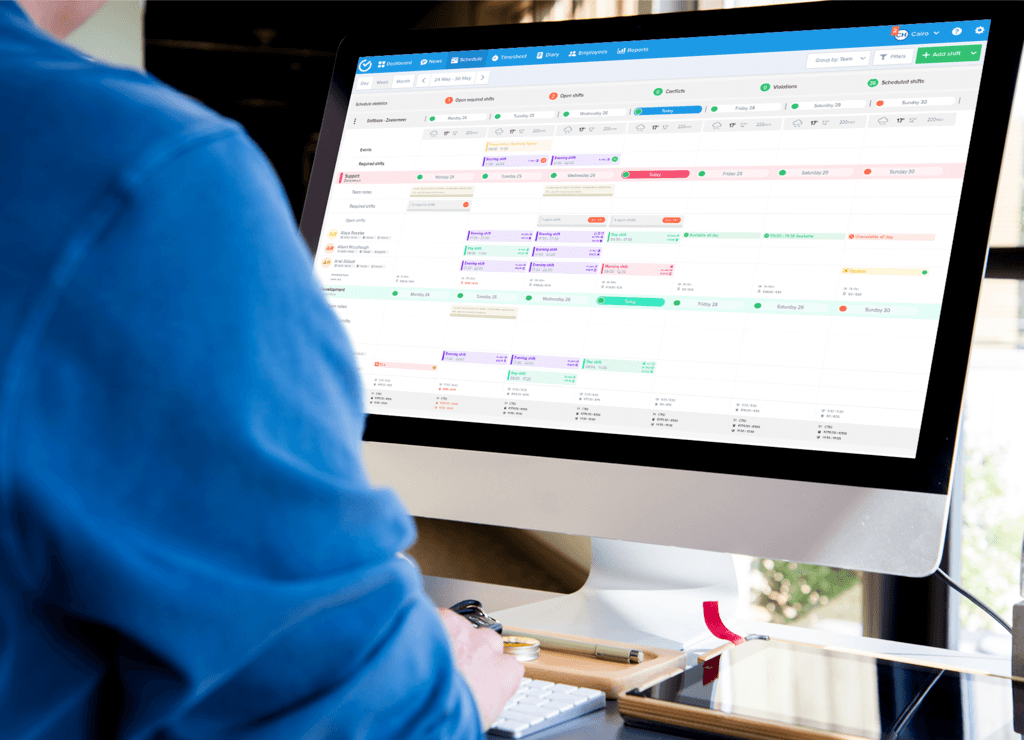In this detailed guide we dive into the concept of flex schedules, understanding the types, benefits and best practices for implementation.
What is a flex schedule?
A flex schedule is a type of work shift schedule that allows employees to choose their starting and finishing times, often referred to as flex time, within certain limits set by their employers. Unlike the traditional 9-to-5 full-time job, a flex schedule gives individuals the flexibility to adjust their hours of work based on their personal and professional needs.
Different types of flex schedules
Several types of flexible schedules have emerged to cater to the diverse needs of both employees and employers. Some of these include:
- Compressed workweek - This allows employees to work the same number of hours per week but in fewer days. For instance, working ten hours a day for four days instead of eight hours for five days.
Useful Read: The 4-day Work Week The Pros and Cons and How to Implement
- Flexible daily hours - Employees can start and end their workday at varying times. This means one can start later or earlier in the day as long as the required hours of work per week are met.
- Results-only work environment (ROWE) - Here, employees are judged based on their results and outputs, not the number of hours they work. It allows employees the utmost flexibility as long as they meet their goals.
Benefits of flex schedules
The adoption of flexible work schedules brings a myriad of benefits:
For employees
- Achieving a better work-life balance becomes more accessible, as they can juggle personal responsibilities alongside work.
- The stress of daily commuting, especially during rush hours, gets reduced significantly.
- Having the power to decide their hours of work often leads to increased productivity since they can work when they feel most energetic and focused.
For employers
- Offering a flexible schedule can boost employee morale, leading to higher retention rates.
- By being more accommodating, employers can tap into a wider talent pool, including those who might need specific working conditions.
- With employees working at different times or even from home, there can be a potential reduction in overhead costs, like utilities or office space requirements.
Potential challenges
With all its advantages, flexible scheduling isn't without its hurdles. Adopting flexible hours means that employers and HR professionals must be aware of certain challenges:
- Managing diverse work schedules: With employees starting and ending their workdays at different times, tracking everyone's hours can become complex. This is especially true if a pay period involves tallying varied working hours.
- Potential loss of face-to-face collaboration: When employees set their own schedules, there might be fewer opportunities for them to meet in person, which could affect team cohesion and brainstorming sessions.
- Consistent communication is crucial: With varied work hours, ensuring that everyone is on the same page can be challenging. If not managed correctly, important information might get missed, leading to scheduling conflicts or missed deadlines.
Implementation: How to introduce a flex schedule

Introducing flexible scheduling in a workplace requires careful planning and execution. It is important to provide advance notice to employees about their schedules to ensure smooth implementation and adherence to the new system. Here’s a step-by-step approach:
1. Assessment phase
Before introducing a new job setup with flexible hours, many employers prioritize evaluating their company's needs and resources.
Gaining direct feedback from both employees and managers is key to understanding their work-hour preferences and gauging interest in the program.
Additionally, it's essential to establish core hours when all employees must be available, regardless of their individual schedules.
2. Pilot program
Rather than initiating a company-wide shift to flexible hours, it's often wise to start with a smaller group or a specific department as a trial.
By leveraging modern tools, such as mobile devices and scheduling software, employers can effectively monitor these flexible schedules and pinpoint any challenges.
It's also crucial to address roles that may require direct supervision, ensuring tasks progress seamlessly even in the absence of in-person oversight.
3. Feedback and iteration
Continuous feedback is a cornerstone of any new process. By regularly collecting insights from both employees and managers, it becomes easier to discern effective practices from problem areas.
Should challenges like scheduling conflicts or adherence to core hours emerge, adjustments to the pilot can be made prior to a broader rollout.
4. Full-scale implementation
After fine-tuning the pilot, the next step is to educate all managers and employees on flex schedules, potentially through workshops or continuing education.
It's vital to set up communication avenues for addressing any concerns or feedback regarding the flexible schedule.
Furthermore, periodic reviews should be instituted to ensure the new system aligns with both company goals and employee contentment.
Best practices and tips for effective flex scheduling
Leverage the right tools
In the era of digitization, there's a multitude of software and applications tailored for scheduling and communication. Employers should invest in tools that not only help in tracking schedules but also facilitate seamless communication among teams.
Such tools can alert managers to potential scheduling conflicts, help employees visualize their workweeks, and ensure that everyone stays connected irrespective of their work hours.
Set clear guidelines
Flexibility doesn't mean ambiguity. It's paramount to have transparent guidelines about when employees should be available, especially during core business hours or crucial meetings. Communication protocols should also be in place.
For instance, employees must inform their team or shift supervisor if there's any change in their typical work hours. This ensures that no one is left in the dark, and business operations run smoothly.
Foster trust and results-oriented evaluation
At the heart of a successful flex schedule is trust. Managers should trust that their employees will fulfill their responsibilities, even if they're not under direct supervision. Instead of focusing on hours clocked in, the emphasis should be on the results produced.
Recognizing and rewarding productivity and outcomes, rather than mere presence, promotes a culture where employees feel valued and are driven to perform at their best.
Tools and technology for managing flex schedules

In this digital age, the management of flexible schedules has become more straightforward thanks to a plethora of tools and technology designed to support both employers and employees. These platforms not only aid in tracking work hours but also enhance communication, collaboration, and productivity in dispersed teams.
Here's a rundown of some essential tools and how they can be harnessed for optimal flex schedule management:
1. Time tracking software
Example: Shiftbase
These tools allow employees to log their working hours, ensuring transparency and accuracy in time reporting. They often come with features like idle time detection, task breakdown, and productivity analytics.
2. Calendar and scheduling platforms
Examples: Google Calendar, Microsoft Outlook, and Calendly.
They enable employees to mark their available hours, schedule meetings during common working hours and set reminders for tasks or appointments. Integrating team calendars can help avoid scheduling conflicts.
3. Communication tools
Examples: Slack, Microsoft Teams, and Zoom.
Ensuring seamless communication is crucial in a flex schedule setup. These platforms facilitate real-time chat, video conferencing, and team collaboration, making it easier to stay connected regardless of varying work hours.
4. Task management and collaboration platforms
Examples: Asana, Trello, and Monday.com.
They allow teams to set, assign, and track tasks. With a clear view of what each team member is working on, it becomes easier to manage workflows and deadlines in a flexible schedule environment.
5. Cloud storage and document collaboration
Examples: Google Drive, Dropbox, and Microsoft OneDrive.
These tools allow employees to access and collaborate on documents in real time from any location. This is particularly useful for teams working in different time zones or flexible hours, ensuring continuity of work.
6. Employee Feedback and Survey Tools
Examples: SurveyMonkey, Typeform, and Google Forms.
Regular feedback is pivotal for the success of flex schedules. These platforms help employers gauge employee satisfaction, collect suggestions, and make necessary adjustments to the system.
7. VPN and security tools
Examples: NordVPN, ExpressVPN, and LastPass.
With employees accessing company data at different times and potentially from different locations, ensuring data security becomes paramount. VPNs offer secure connections, while tools like LastPass manage passwords securely.
Incorporating these tools and technologies can drastically simplify the management of flex schedules, enhancing efficiency, transparency, and trust between employers and employees.

- Create rosters quickly
- Insight into labor costs
- Access anywhere via the app

Leverage flex schedules with Shiftbase
Implementing flex schedules can be a breeze with Shiftbase. Our platform's specialized features such as employee scheduling make it easy to incorporate flexible work hours, while time tracking ensures accurate reporting. Shiftbase simplifies the process, making it easier for you to offer this valuable flexibility to your employees.
Interested in transitioning to flex schedules? Begin a free 14-day trial with Shiftbase to discover how we can support your shift toward more flexible work arrangements.

- Create rosters quickly
- Insight into labor costs
- Access anywhere via the app



